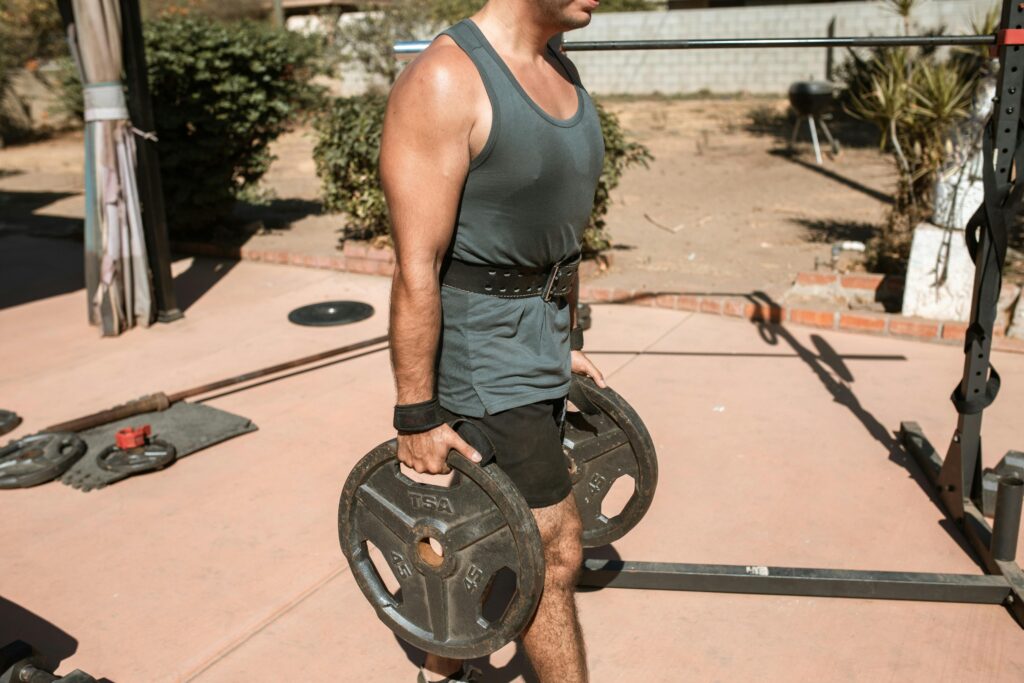Table of Contents
Introduction
Opening Hook: Imagine a workout that not only sculpts your muscles but also boosts your metabolism, improves your bone density, and enhances your overall physical performance. Welcome to the world of strength training.
Importance of Strength Training: Strength training, also known as resistance training, is a crucial component of a well-rounded fitness regimen. It’s not just about lifting heavy weights; it’s about building a foundation for a healthier, stronger, and more resilient body.
Thesis Statement: In this blog, we will explore the essentials of strength training, including its benefits, how to get started, key exercises, proper form, nutrition, recovery, and tips for staying motivated.
Section 1: Understanding Strength Training
Definition: Strength training involves performing exercises that improve muscle strength and endurance. This type of training uses resistance in the form of weights, body weight, or resistance bands to create muscular contractions.
Types of Strength Training:
• Weight Lifting: Utilizing free weights such as dumbbells, barbells, and kettlebells.
• Bodyweight Exercises: Movements like push-ups, pull-ups, and squats that use your body weight as resistance.
• Resistance Band Exercises: Using elastic bands to provide resistance during exercises.
• Machine Workouts: Equipment found in gyms designed to target specific muscle groups.
Benefits:
• Muscle Building: Increases muscle mass and strength.
• Bone Density Improvement: Enhances bone strength, reducing the risk of osteoporosis.
• Metabolic Boost: Increases resting metabolic rate, helping with weight management.
• Enhanced Physical Performance: Improves overall athletic performance.
• Injury Prevention: Strengthens muscles, tendons, and ligaments, reducing the risk of injuries.

Section 2: Getting Started with Strength Training https://www.self.com/story/8-strength-exercises
Assessing Fitness Level: Before starting, assess your current fitness level. This can involve consulting a fitness professional or performing simple self-assessments to understand your starting point.
Setting Goals: Clearly define your fitness goals, whether it’s building muscle, losing fat, or improving overall strength. Specific, measurable, achievable, relevant, and time-bound (SMART) goals are essential for tracking progress.
Creating a Plan:
• Frequency: Aim for 3-4 strength training sessions per week.
• Duration: Each session should last 45-60 minutes.
• Progressive Overload Principle: Gradually increase the weight, repetitions, or intensity of your workouts to continuously challenge your muscles and stimulate growth.
Section 3: Essential Strength Training Exercises
Upper Body:
• Push-ups: A foundational bodyweight exercise that targets the chest, shoulders, and triceps.
• Bench Press: A compound movement that primarily works the chest but also engages the shoulders and triceps.
• Dumbbell Rows: Target the upper back and biceps, improving posture and upper body strength.
• Shoulder Press: Strengthens the shoulders and triceps.
Lower Body:
• Squats: A fundamental exercise that targets the quadriceps, hamstrings, glutes, and core.
• Deadlifts: Focus on the hamstrings, glutes, lower back, and core, improving overall strength and stability.
• Lunges: Work the quadriceps, hamstrings, and glutes while improving balance.
• Leg Press: A machine exercise that isolates the lower body muscles, particularly the quadriceps.
Core:
• Planks: Strengthen the core, shoulders, and back, enhancing overall stability.
• Russian Twists: Target the oblique muscles, improving rotational strength.
• Leg Raises: Focus on the lower abdominal muscles.
• Bicycle Crunches: Engage the entire core, including the rectus abdominis and obliques.

Section 4: Proper Form and Technique
Importance of Form: Proper form is crucial to avoid injuries and maximize the effectiveness of each exercise. Poor technique can lead to strains, sprains, and other injuries.
Common Mistakes: Common errors include lifting too heavy, using improper posture, and neglecting warm-up and cool-down routines.
Tips for Good Form: Maintain a neutral spine, engage your core, and control your movements. Breathe properly—inhale during the eccentric (lowering) phase and exhale during the concentric (lifting) phase.
Section 5: Progression and Variation
Progressive Overload: To continue seeing results, gradually increase the resistance or complexity of your workouts. This can be done by adding more weight, increasing repetitions, or reducing rest time between sets.
Changing Routines: Avoid plateaus by regularly changing your workout routine. This can involve introducing new exercises, adjusting sets and reps, or trying different training techniques like supersets or circuit training.
Incorporating Different Equipment: Use a variety of equipment, such as free weights, machines, and resistance bands, to target muscles differently and keep workouts interesting.
Section 6: Nutrition for Strength Training
Macronutrients:
• Protein: Essential for muscle repair and growth. Aim for a protein-rich diet with sources like lean meats, fish, eggs, and plant-based proteins.
• Carbohydrates: Provide the energy needed for intense workouts. Include complex carbs like whole grains, fruits, and vegetables.
• Fats: Healthy fats support hormone production and overall health. Incorporate sources like avocados, nuts, seeds, and olive oil.
Hydration: Stay properly hydrated to maintain performance and support recovery. Drink water before, during, and after workouts.
Pre- and Post-Workout Nutrition:
• Pre-Workout: Consume a balanced meal with carbs and protein 1-2 hours before training. Options include a banana with peanut butter or a protein shake with fruit.
• Post-Workout: Eat a meal rich in protein and carbs within 30 minutes to an hour after your workout to aid recovery. Good choices are a grilled chicken salad or a smoothie with protein powder and berries.

Section 7: Recovery and Rest
Importance of Rest Days: Muscles need time to repair and grow. Incorporate at least one or two rest days per week into your routine.
Active Recovery: Engage in light activities like walking, yoga, or stretching on rest days to promote blood flow and reduce muscle stiffness.
Sleep: Aim for 7-9 hours of sleep per night to support muscle recovery and overall health. Quality sleep is crucial for physical and mental well-being.
Section 8: Staying Motivated
Tracking Progress: Use a fitness journal or app to log your workouts, track progress, and stay motivated. Recording your achievements can help you stay focused and committed.
Setting Milestones: Break your goals into smaller, manageable milestones. Celebrate each milestone to maintain motivation and recognize your progress.
Finding a Workout Buddy: Partnering with a friend can provide accountability and support. A workout buddy can also make exercise more enjoyable and help you push through challenging workouts.
Conclusionhttps://fitnessblog4u.com/wp-admin/post.php?post=219&action=edit
Recap of Key Points: Strength training is an essential component of a healthy lifestyle, offering numerous physical and mental benefits. By understanding the basics, starting with a solid plan, and following proper techniques, you can achieve your fitness goals.
Encouragement: No matter where you are on your fitness journey, remember that consistency is key. Stay motivated, be patient, and enjoy the process of becoming stronger and healthier.
Call to Action: Ready to start your strength training journey? Share your experiences, ask questions, or suggest topics for future blogs in the comments below. Let’s build a stronger community together!
Additional Resources
Links to Further Reading:
• “The Science of Strength Training” by Austin Current
• “Starting Strength” by Mark Rippetoe
Recommended Workouts:
• Beginner: Full-body workout three times a week.
• Intermediate: Upper/lower split workout four times a week.
• Advanced: Push/pull/legs split workout six times a week.
Fitness Apps and Tools:
• MyFitnessPal: For tracking nutrition and workouts.
• Strong Lifts 5×5: For strength training routines.
• JEFIT: For creating and tracking workout plans.
By following this detailed guide, you can create an engaging and informative blog that helps your readers understand the importance of strength training and how to effectively incorporate it into their fitness routines.


